
Indian Removal
Indian Removal
At the time Jackson took office, 125,000 Native Americans still lived east of the Mississippi River. Cherokee, Choctaw, Chickasaw, and Creek Indians—60,000 strong—held millions of acres in what would become the Southern cotton kingdom stretching across Georgia, Alabama, and Mississippi. The key political issues were whether these Native American peoples would be permitted to block white expansion and whether the U.S. government and its citizens would abide by previously made treaties.
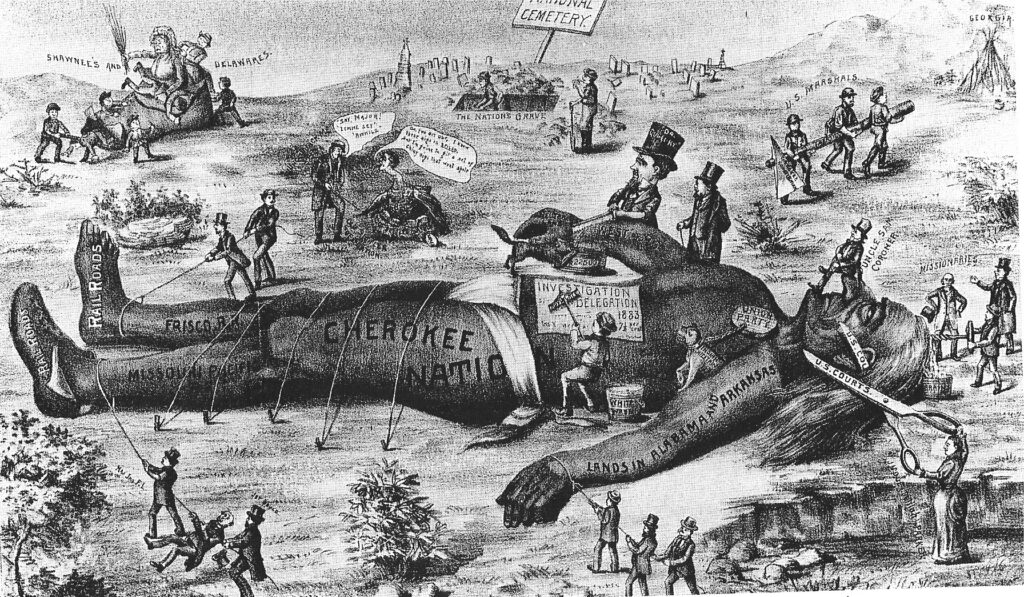
Since Jefferson’s presidency, two conflicting policies, assimilation and removal, had governed the treatment of Native Americans. Assimilation encouraged Indians to adopt the customs and economic practices of white Americans. The government provided financial assistance to missionaries in order to Christianize and educate Native Americans and convince them to adopt single-family farms. Proponents defended assimilation as the only way Native Americans would be able to survive in a white-dominated society.
By the 1820s, the Cherokee had demonstrated the ability of Native Americans to adapt to changing conditions while maintaining their tribal heritage. Sequoyah, a leader of these people, had developed a written alphabet. Soon the Cherokee opened schools, established churches, built roads, operated printing presses, and even adopted a constitution.
The other policy—Indian removal—was first suggested by Thomas Jefferson as the only way to ensure the survival of Native American cultures. The goal of this policy was to encourage the voluntary migration of Indians westward to tracts of land where they could live free from white harassment.
As early as 1817, James Monroe declared that the nation’s security depended on rapid settlement along the Southern coast and that it was in the best interests of Native Americans to move westward. In 1825, he set before Congress a plan to resettle all eastern Indians on tracts in the West where whites would not be allowed to live. After initially supporting both policies, Jackson favored removal as the solution to the controversy.
This shift in federal Indian policy came partly as a result of a controversy between the Cherokee nation and the state of Georgia. The Cherokee people had adopted a constitution asserting sovereignty over their land. The state responded by abolishing tribal rule and claiming that the Cherokee fell under its jurisdiction. The discovery of gold on Cherokee land triggered a land rush, and the Cherokee nation sued to keep white settlers from encroaching on their territory.
In two important cases, Cherokee Nation v. Georgia (1831) and Worcester v. Georgia (1832), the Supreme Court ruled that states could not pass laws conflicting with federal Indian treaties and that the federal government had an obligation to exclude white intruders from Indian lands. Angered, Jackson is said to have exclaimed: “John Marshall has made his decision; now let him enforce it.”
The primary thrust of Jackson’s removal policy was to encourage Native Americans to sell their homelands in exchange for new lands in Oklahoma and Arkansas. Such a policy, the president maintained, would open new farmland to whites while offering Indians a haven where they would be free to develop at their own pace. “There,” he wrote, “your white brothers will not trouble you, they will have no claims to the land, and you can live upon it, you and all your children, as long as the grass grows or the water runs, in peace and plenty.”
Pushmataha, a Choctaw chieftain, called on his people to reject Jackson’s offer. Far from being a “country of tall trees, many water courses, rich lands and high grass abounding in games of all kinds,” the promised preserve in the West was simply a barren desert. Jackson responded by warning that if the Choctaw refused to move west, he would destroy their nation.
During the winter of 1831, the Choctaw became the first tribe to walk the “Trail of Tears” westward. Promised government assistance failed to arrive, and malnutrition, exposure, and a cholera epidemic killed many members of the nation. Then, in 1836, the Creek suffered the hardships of removal. About 3,500 of the tribe’s 15,000 members died along the westward trek. Those who resisted removal were bound in chains and marched in double file.
Emboldened by the Supreme Court decisions declaring that Georgia law had no force on Indian Territory, the Cherokees resisted removal. Fifteen thousand Cherokee joined in a protest against Jackson’s policy: “Little did [we] anticipate that when taught to think and feel as the American citizen … [we] were to be despoiled by [our] guardian, to become strangers and wanderers in the land of [our] fathers, forced to return to the savage life, and to seek a new home in the wilds of the far west, and that without [our] consent.” The federal government bribed a faction of the tribe to leave the land in exchange for transportation costs and $5 million, but most Cherokees held out until 1838, when the army evicted them from their land. All told, 4,000 of the 15,000 Cherokee died along the trail to Indian Territory in what is now Oklahoma.
A number of other tribes also organized resistance against removal. In the Old Northwest, the Sauk and Fox Indians fought the Black Hawk War (1832) to recover ceded tribal lands in Illinois and Wisconsin. The Indians claimed that when they had signed the treaty transferring title to their land, they had not understood the implications of the action. “I touched the goose quill to the treaty,” said Chief Black Hawk, “not knowing, however, that by that act I consented to give away my village.” The United States army and the Illinois state militia ended the resistance by wantonly killing nearly 500 Sauk and Fox men, women, and children who were trying to retreat across the Mississippi River. In Florida, the military spent seven years putting down Seminole resistance at a cost of $20 million and 1,500 casualties, and even then succeeding only after the treacherous act of kidnapping the Seminole leader, Osceola, during peace talks.
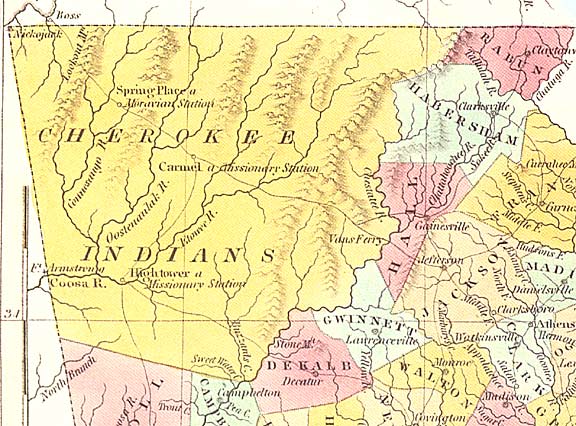
By twentieth-century standards, Jackson’s Indian policy was both callous and inhumane. Despite the semblance of legality—94 treaties were signed with Indians during Jackson’s presidency—Native American migrations to the West almost always occurred under the threat of government coercion. Even before Jackson’s death in 1845, it was obvious that tribal lands in the West were no more secure than Indian lands had been in the East. In 1851, Congress passed the Indian Appropriations Act, which sought to concentrate the western Native American population on reservations.
Why were such morally indefensible policies adopted?
Because many white Americans regarded Indian control of land and other natural resources as a serious obstacle to their desire for expansion and as a potential threat to the nation’s security. Even if the federal government had wanted to, it probably lacked the resources and military means necessary to protect the eastern Indians from encroaching white farmers, squatters, traders, and speculators. By the 1830s, a growing number of missionaries and humanitarians agreed with Jackson that Indians needed to be resettled westward for their own protection.
Removal failed in large part because of the nation’s commitment to limited government and its lack of experience with social welfare programs. Contracts for food, clothing, and transportation were awarded to the lowest bidders, many of whom failed to fulfill their contractual responsibilities. Indians were resettled on semi-arid lands, unsuited for intensive farming. The tragic outcome was readily foreseeable.
The problem of preserving native cultures in the face of an expanding nation was not confined to the United States. Jackson’s removal policy can only be properly understood when seen as part of a broader process: the political and economic conquest of frontier regions by expanding nation states. During the early decades of the nineteenth century, Western nations were penetrating into many frontier areas, including the steppes of Russia, the pampas of Argentina, the veldt of South Africa, the outback of Australia, and the American West. In each of these regions, national expansion was justified on the grounds of strategic interest (to preempt settlement by other powers) or in the name of opening valuable land to white settlement and development. And in each case, expansion was accompanied by the removal or wholesale killing of native peoples.
The Trail of Tears
The largest group of Cherokees left Tennessee in the late fall of 1838, followed the northern route, and arrived in Indian Territory in March. What challenges would these people have faced?
In his Second Annual Message to Congress in 1830, President Jackson laid out his position on Indian removal:
The consequences of a speedy removal will be important to the United States, to individual States, and to the Indians themselves. …
It will separate the Indians from immediate contact with settlements of whites; free them from the power of the States; enable them to pursue happiness in their own way and under their own rude institutions; will retard the progress of decay, which is lessening their numbers, and perhaps cause them gradually, under the protection of the Government and through the influence of good counsels, to cast off their savage habits and become an interesting, civilized, and Christian community. These consequences, some of them so certain and the rest so probable, make the complete execution of the plan sanctioned by Congress at their last session an object of much solicitude.
Toward the aborigines of the country no one can indulge a more friendly feeling than myself, or would go further in attempting to reclaim them from their wandering habits and make them a happy, prosperous people.
The tribes which occupied the countries now constituting the Eastern States were annihilated or have melted away to make room for the whites. The waves of population and civilization are rolling to the westward, and we now propose to acquire the countries occupied by the red men of the South and West by a fair exchange, and, at the expense of the United States, to send them to a land where their existence may be prolonged and perhaps made perpetual.
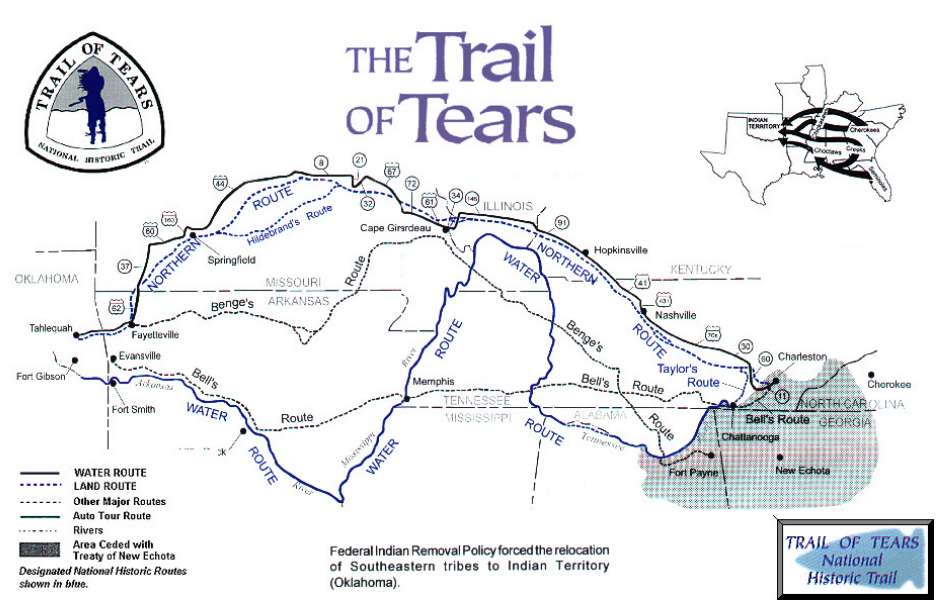
Doubtless it will be painful to leave the graves of their fathers; but what do they more than our ancestors did or than our children are now doing? To better their condition in an unknown land our forefathers left all that was dear in earthly objects. Our children by thousands yearly leave the land of their birth to seek new homes in distant regions. Does Humanity weep at these painful separations from every thing, animate and inanimate, with which the young heart has become entwined? Far from it. It is rather a source of joy that our country affords scope where our young population may range unconstrained in body or in mind, developing the power and faculties of man in their highest perfection.
These [white emigrants] remove hundreds and almost thousands of miles at their own expense, purchase the lands they occupy, and support themselves at their new homes from the moment of their arrival. Can it be cruel in this Government when, by events which it can not control, the Indian is made discontented in his ancient home to purchase his lands, to give him a new and extensive territory, to pay the expense of his removal, and support?
Jackson’s Letter, 1835
In 1835, President Jackson sent the following letter to the Cherokee National Council:
My Friends:
I have long viewed your condition with great interest. For many years I have been acquainted with your people, and under all variety of circumstances in peace and war. You are now placed in the midst of a white population. Your peculiar customs, which regulated your intercourse with one another, have been abrogated by the great political community among which you live; and you are now subject to the same laws which govern the other citizens of Georgia and Alabama.
I have no motive, my friends, to deceive you. I am sincerely desirous to promote your welfare. Listen to me, therefore, while I tell you that you cannot remain where you now are. Circumstances that cannot be controlled, and which are beyond the reach of human laws, render it impossible that you can flourish in the midst of a civilized community. You have but one remedy within your reach. And that is, to remove to the West and join your countrymen, who are already established there. And the sooner you do this the sooner you will commence your career of improvement and prosperity.

Historical Debates
Major Ridge Supports the Treaty
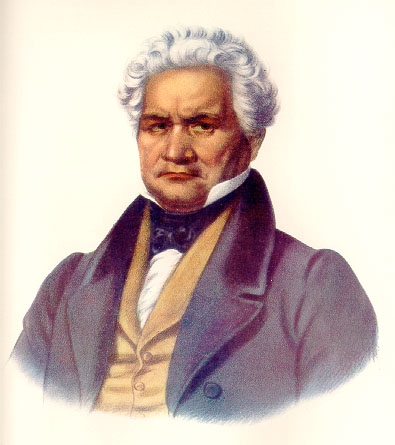
One group of Cherokees agreed to sign a treaty. Major Ridge, a leader of that faction, defended that decision and spoke of his reasons for supporting the treaty:
I am one of the native sons of these wild woods. I have hunted the deer and turkey here, more than fifty years. I have fought your battles, have defended your truth and honesty, and fair trading. The Georgians have shown a grasping spirit lately; they have extended their laws, to which we are unaccustomed, which harass our braves and make the children suffer and cry. I know the Indians have an older title than theirs. We obtained the land from the living God above. They got their title from the British. Yet they are strong and we are weak. We are few, they are many. We cannot remain here in safety and comfort. I know we love the graves of our fathers. We can never forget these homes, but an unbending, iron necessity tells us we must leave them. I would willingly die to preserve them, but any forcible effort to keep them will cost us our lands, our lives and the lives of our children. There is but one path of safety, one road to future existence as a Nation. That path is open before you. Make a treaty of cession. Give up these lands and go over beyond the great Father of Waters.
A Description of the Removal of the Cherokees
Private John G. Burnett, Captain Abraham McClellan’s Company, 2nd Regiment, 2nd Brigade, Mounted Infantry, Cherokee Indian Removal, 1838-39 to his children 1890.
I was born at Kings Iron Works in Sulllivan County, Tennessee, December the 11th, 1810. I grew into manhood fishing in Beaver Creek and roaming through the forest hunting the deer and the wild boar and the timber wolf. Often spending weeks at a time in the solitary wilderness with no companions but my rifle, hunting knife, and a small hatchet that I carried in my belt in all of my wilderness wanderings.
On these long hunting trips I met and became acquainted with many of the Cherokee Indians, hunting with them by day and sleeping around their camp fires by night. I learned to speak their language, and they taught me the arts of trailing and building traps and snares.
On one of my long hunts in the fall of 1829, I found a young Cherokee who had been shot by a roving band of hunters and who had eluded his pursuers and concealed himself under a shelving rock. Weak from loss of blood, the poor creature was unable to walk and almost famished for water. I carried him to a spring, bathed and bandaged the bullet wound, and built a shelter out of bark peeled from a dead chestnut tree. I nursed and protected him feeding him on chestnuts and toasted deer meat. When he was able to travel I accompanied him to the home of his people and remained so long that I was given up for lost. By this time I had become an expert rifleman and fairly good archer and a good trapper and spent most of my time in the forest in quest of game.
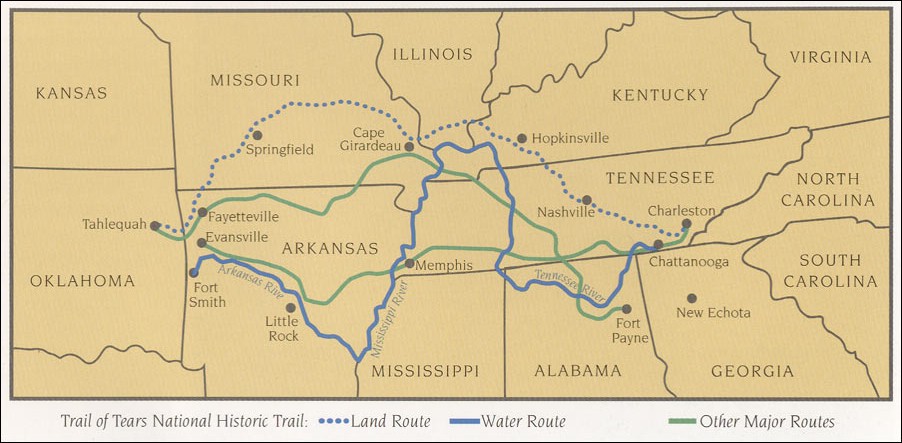
The removal of Cherokee Indians from their life long homes in the year of 1838 found me a young man in the prime of life and a Private soldier in the American Army. Being acquainted with many of the Indians and able to fluently speak their language, I was sent as interpreter into the Smoky Mountain Country in May, 1838, and witnessed the execution of the most brutal order in the History of American Warfare. I saw the helpless Cherokees arrested and dragged from their homes and driven at the bayonet point into the stockades. And in the chill of a drizzling rain on an October morning I saw them loaded like cattle or sheep into six hundred and forty-five wagons and started toward the west… Many of these helpless people did not have blankets and many of them had been driven from home barefooted.
On the morning of November the 17th we encountered a terrific sleet and snow storm with freezing temperatures and from that day until we reached the end of the fateful journey on March the 26th, 1839, the sufferings of the Cherokees were awful. The trail of the exiles was a trail of death. They had to sleep in the wagons and on the ground without fire. And I have known as many as twenty-two of them to die in one night of pneumonia due to ill treatment, cold, and exposure….
The only trouble that I had with anybody on the entire journey to the west was a brutal teamster by the name of Ben McDonal, who was using his whip on an old feeble Cherokee to hasten him into the wagon. The sight of that old and nearly blind creature quivering under the lashes of a bull whip was too much for me. I attempted to stop McDonal and it ended in a personal encounter. He lashed me across the face, the wire tip on his whip cutting a bad gash in my cheek. The little hatchet that I had carried in my hunting days was in my belt and McDonal was carried unconscious from the scene…
Chief Junaluska was personally acquainted with President Andrew Jackson. Junaluska had taken 500 of the flower of his Cherokee scouts and helped Jackson to win the battle of the Horse Shoe, leaving 33 of them dead on the field. And in that battle Junaluska had drove his tomahawk through the skull of a Creek warrior, when the Creek had Jackson at his mercy.
Chief John Ross sent Junaluska as an envoy to plead with President Jackson for protection for his people, but Jackson’s manner was cold and indifferent toward the rugged son of the forest who had saved his life. He met Junaluska, heard his plea but curtly said, “Sir, your audience is ended. There is nothing I can do for you.” The doom of the Cherokee was sealed. Washington, D.C., had decreed that they must be driven West and their lands given to the white man, and in May 1838, an army of 4,000 regulars, and 3,000 volunteer soldiers under command of General Winfield Scott, marched into the Indian country and wrote the blackest chapter on the pages of American history.
Men working in the fields were arrested and driven to the stockades. Women were dragged from their homes by soldiers whose language they could not understand. Children were often separated from their parents and driven into the stockades with the sky for a blanket and the earth for a pillow. And often the old and infirm were prodded with bayonets to hasten them to the stockades…
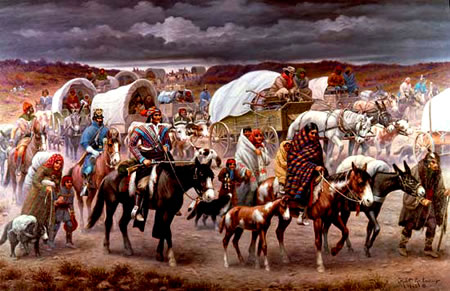
Chief Junaluska who had saved President Jackson’s life at the battle of Horse Shoe [Bend]… said, “Oh my God, if I had known at the battle of the Horse Shoe what I know now, American history would have been differently written.”
At this time, 1890, we are too near the removal of the Cherokees for our young people to fully understand the enormity of the crime that was committed against a helpless race. Truth is, the facts are being concealed from the young people of today. School children of today do not know that we are living on lands that were taken from a helpless race at the bayonet point to satisfy the white man’s greed.
Future generations will read and condemn the act and I do hope posterity will remember that private soldiers like myself, and like the four Cherokees who were forced by General Scott to shoot an Indian Chief and his children, had to execute the orders of our superiors. We had no choice in the matter…
Murder is murder, and somebody must answer. Somebody must explain the streams of blood that flowed in the Indian country in the summer of 1838. Somebody must explain the 4000 silent graves that mark the trail of the Cherokees to their exile. I wish I could forget it all, but the picture of 645 wagons lumbering over the frozen ground with their cargo of suffering humanity still lingers in my memory.
Let the historian of a future day tell the sad story with its sighs, its tears and dying groans. Let the great Judge of all the earth weigh our actions and reward us according to our work.